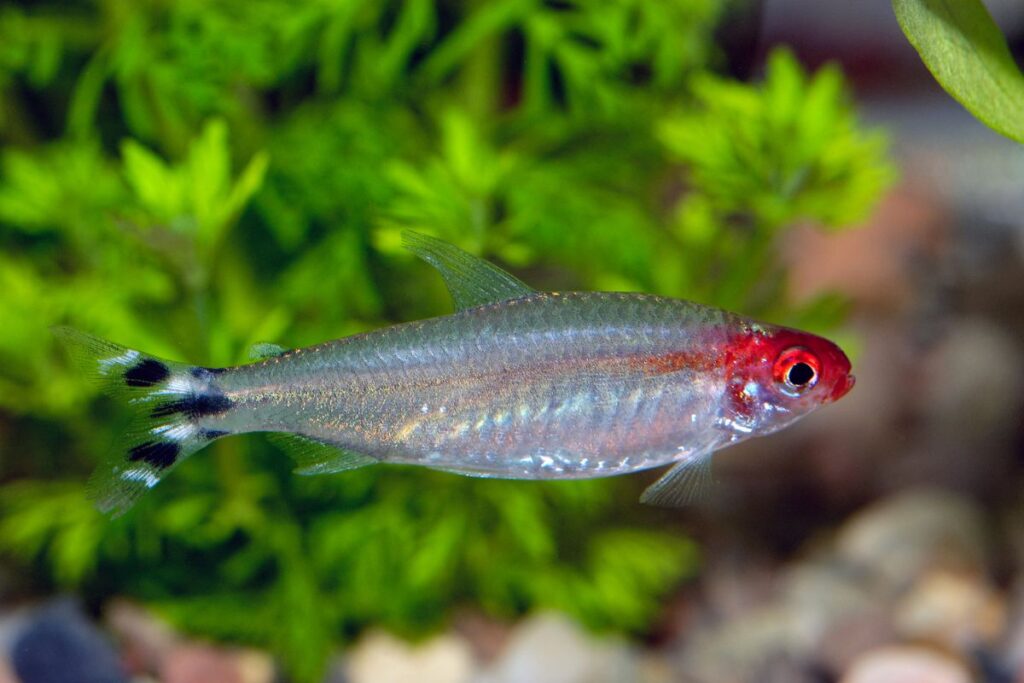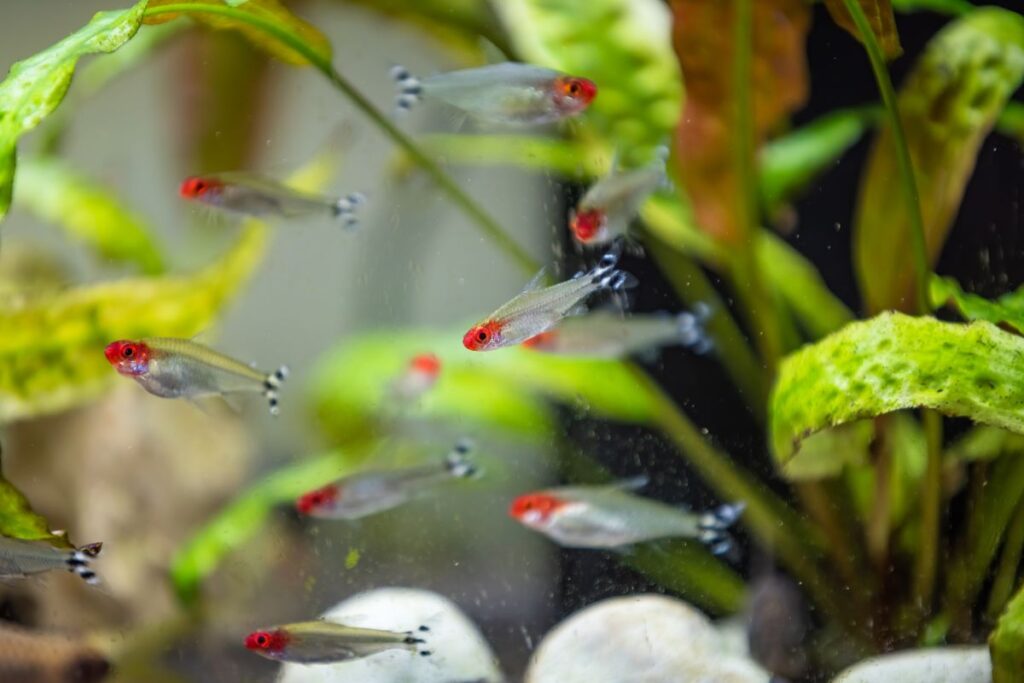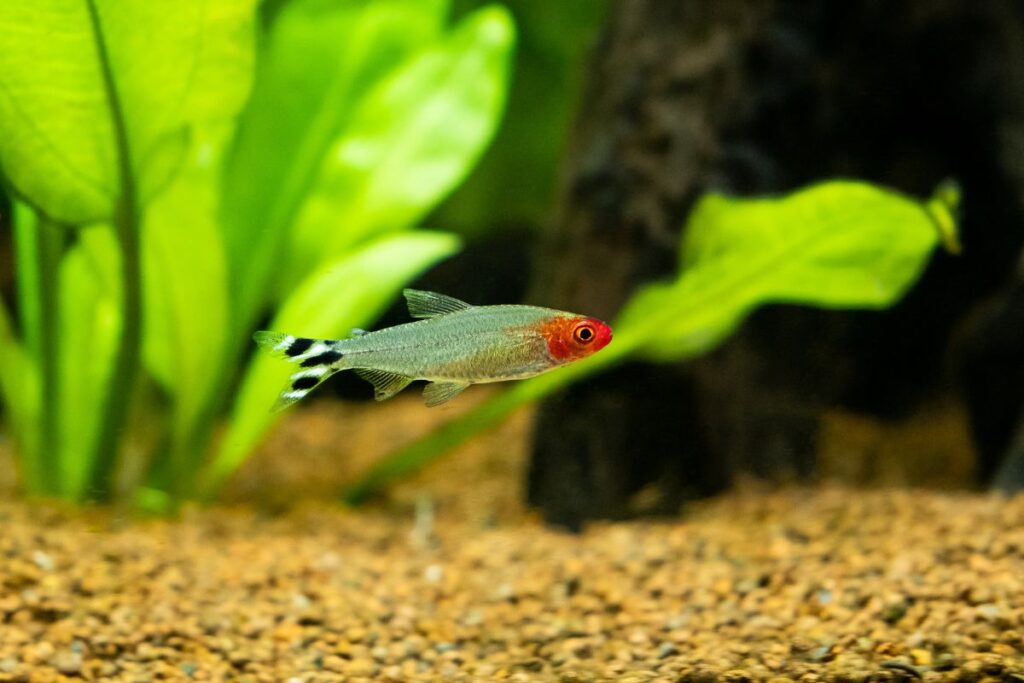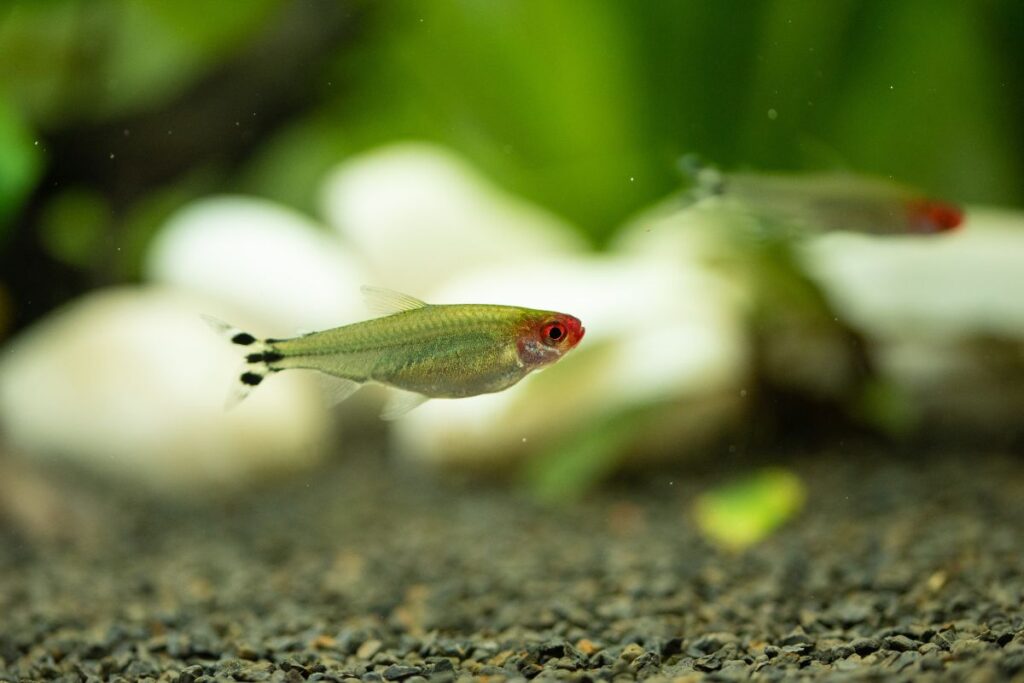If you’re looking for a colorful and active fish to add to your aquarium, the Rummynose Tetra might be just what you need. These small and lively fish are popular among aquarium enthusiasts for their striking red noses and schooling behavior. In this article, I’ll share everything you need to know about caring for Rummynose Tetras, from their ideal tank setup to their feeding habits.
Rummy nose tetras require a well-maintained aquarium with suitable water conditions, a varied diet, and a peaceful environment. They need a pH range of 5.5-7.5 and a temperature range between 75-82°F. The aquarium should be planted, and regular water changes should be performed to ensure their health. They are peaceful and social fish, making them an excellent choice for community tanks.
As an aquarium hobbyist myself, I’ve had the pleasure of keeping Rummynose Tetras in my own tank. These fish are not only beautiful to look at, but they also have a fascinating behavior. Watching them swim together in a school is a sight to behold. But before you bring these fish home, it’s important to understand their specific care requirements to ensure they thrive in your aquarium.
In this comprehensive guide, I’ll cover all aspects of Rummynose Tetra care, including water parameters, tank size, feeding, and breeding. Whether you’re a beginner or an experienced aquarist, you’ll find valuable information to help you provide the best possible care for your Rummynose Tetras.

Table of Contents
Species Summary
Origin
The Rummynose Tetra is a freshwater fish that originated in the Amazon River Basin in South America. They are commonly found in Brazil, Peru, and Colombia.
Lifespan
The Rummynose Tetra has a relatively short lifespan of 3-5 years in captivity. However, with proper care and a healthy environment, they can live up to 7 years.
Appearance
The Rummynose Tetra is a small, colorful fish that is easily recognizable by its bright red nose and silver body. Their dorsal fins are tall and pointed, while their caudal fins are forked.
They have a streamlined body shape, which allows them to swim swiftly through the water.
Size
Rummynose Tetras are a small species of fish, typically growing to only 1-1.5 inches in length. Females are slightly larger than males.
Growth Rate
The growth rate of Rummynose Tetras is relatively slow. It can take up to a year for them to reach their full size. However, with proper care and a healthy environment, they can grow to their full potential.
Behavior & Temperament
Rummynose Tetras are peaceful and social fish that do well in groups of 6 or more. They are active swimmers and enjoy having plenty of space to swim around.
They are also known for their schooling behavior, which is a natural defense mechanism against predators.
Male vs Female
The easiest way to distinguish between male and female Rummynose Tetras is by looking at their size. Females are slightly larger than males.
Additionally, during breeding season, males will develop more intense colors and will display more active courtship behavior.
Personally, I have kept Rummynose Tetras in my aquarium for several years and have found them to be a delightful addition to my tank.
They are active, colorful, and always seem to be in a good mood. I highly recommend them to anyone looking for a peaceful and easy-to-care-for species of fish.
Setting up the Aquarium

Tank Size
I recommend a minimum tank size of 20 gallons for a small group of Rummynose Tetras. They are active swimmers and need enough space to move around comfortably. A larger tank will also help maintain stable water parameters.
Lighting
Rummynose Tetras prefer dim lighting, so avoid bright lights that can cause stress. A timer can be used to regulate the lighting and provide a consistent day-night cycle.
Filtration & Aeration
A good filtration system is crucial for the health of your Rummynose Tetras. A hang-on-back filter or canister filter can be used. Aeration is also important to maintain oxygen levels in the water. An air stone or sponge filter can be used for this purpose.
Heater
Rummynose Tetras require a stable water temperature between 75-82°F. A submersible heater can be used to maintain the desired temperature.
Substrate
A fine-grained substrate like sand or gravel is recommended for Rummynose Tetras. They like to forage for food on the bottom of the tank, so a soft substrate will prevent injury to their delicate barbels.
Aquarium Decor
Rummynose Tetras prefer a heavily planted tank with plenty of hiding places. Driftwood, rocks, and caves can also be used to create a natural-looking environment.
Plants
Live plants like Java fern, Anubias, and Amazon sword are great choices for a Rummynose Tetra tank. They provide hiding places and help maintain water quality by absorbing excess nutrients.
I remember when I first set up my Rummynose Tetra tank, I was so excited to create a natural-looking environment for them.
I spent hours researching the best plants and decor to use. It was worth it to see how happy and active they are in their new home.
Water Parameters

Water Temperature
I keep my Rummynose Tetras in a tank with a water temperature between 75-82°F (24-28°C).
It’s important to keep the temperature stable, as fluctuations can stress out your fish. Use a reliable heater and thermometer to monitor the temperature regularly.
Water pH
Rummynose Tetras prefer slightly acidic water with a pH between 6.0-7.0. I recommend testing your water regularly to ensure the pH stays within this range.
If it’s too high or too low, you can adjust it with pH adjusters or natural methods like adding driftwood or almond leaves.
Water Hardness
These fish prefer soft to moderately hard water with a dH between 2-12. If your water is too hard, you can use a water softener or add peat moss to the filter.
If it’s too soft, you can add crushed coral or limestone to the substrate.
Water Changes
Regular water changes are essential for maintaining good water quality and keeping your Rummynose Tetras healthy. I recommend changing 20-30% of the water every week.
Use a gravel vacuum to remove any debris and uneaten food from the substrate.
When doing water changes, make sure the new water is the same temperature and pH as the tank water to avoid shocking your fish.
You can also use a water conditioner to remove chlorine and other harmful chemicals from tap water.
Feeding Rummynose Tetras

Diet
When it comes to feeding Rummynose Tetras, a varied diet is key to keeping them healthy and happy. In the wild, these fish feed on small insects, crustaceans, and plant matter.
In captivity, you can replicate this diet by offering a mix of high-quality flakes, pellets, frozen or live foods.
I like to feed my Rummynose Tetras a mix of flakes and frozen foods. I find that they particularly enjoy bloodworms and brine shrimp.
I also like to offer them some fresh vegetables like blanched spinach or zucchini. These provide additional nutrients and fiber that are important for their overall health.
Feeding Schedule
It’s important to establish a feeding schedule for your Rummynose Tetras. These fish have small stomachs and should be fed small amounts several times a day.
Overfeeding can lead to health problems and poor water quality in your aquarium.
I recommend feeding your Rummynose Tetras twice a day, once in the morning and once in the evening.
Feed only what they can consume in a few minutes, and remove any uneaten food from the tank to prevent it from fouling the water.
Remember to also vary their diet throughout the week to ensure they are getting all the nutrients they need.
A varied diet will also help keep your fish interested and engaged in their food, which can help prevent boredom and stress.
By following these feeding tips, you can help ensure that your Rummynose Tetras thrive in your aquarium and live a healthy and happy life.
Rummynose Tetra Behavior

Schooling Behavior
As someone who has kept Rummynose Tetras in my aquarium, I can attest to their schooling behavior. These fish are social creatures and should be kept in groups of at least six.
When they feel comfortable, they will form tight schools and swim together in unison. It’s a beautiful sight to see!
Compatibility with Other Fish
Rummynose Tetras are generally peaceful fish and can coexist with other peaceful fish species. However, they can become aggressive towards each other if they feel threatened or stressed.
It’s important to provide plenty of hiding spots and plants in the aquarium to help alleviate stress.
Best Tank Mates for Rummy Nose Tetra
Some of the best tank mates for Rummynose Tetras include other peaceful shoaling fish such as Neon Tetras, Harlequin Rasboras, and Corydoras Catfish.
Avoid keeping them with aggressive or predatory fish as they can become stressed and even injured.
- Neon Tetras
- Harlequin Rasboras
- Corydoras Catfish
How Many Rummy Nose Tetras Should be Kept Together

As mentioned earlier, Rummynose Tetras should be kept in groups of at least six. However, the more the merrier!
A larger group of Rummynose Tetras will result in a more impressive display of schooling behavior.
Common Rummynose Tetra Health Issues
Diseases
As with any fish, Rummynose Tetras are susceptible to a variety of diseases. One common ailment is Ich, which is caused by a parasite that appears as white spots on the fish’s body.
Another common disease is fin rot, which can be caused by poor water quality or injury to the fins.
Dropsy is also a concern, which is a bacterial infection that causes the fish to become bloated and lethargic.
Symptoms
It’s important to keep an eye out for any signs of illness in your Rummynose Tetras. Symptoms of Ich include white spots on the fish’s body, while fin rot is characterized by frayed or discolored fins.
Dropsy can cause the fish to become bloated and lethargic, and they may also have trouble swimming.
Treatment
If you notice any signs of illness in your Rummynose Tetras, it’s important to act quickly. For Ich, you can treat the fish with medication that is available at most pet stores.
Fin rot can often be treated by improving water quality and adding aquarium salt to the tank.
Dropsy may require antibiotics, but it’s important to consult with a veterinarian or experienced fish keeper before administering any medication.
Personally, I have had experience with fin rot in my own Rummynose Tetras.
I noticed that their fins were becoming frayed and discolored, so I immediately tested the water quality and found that the ammonia levels were too high.
I did a water change and added aquarium salt to the tank, and within a few days, their fins had started to heal.
Signs of a Healthy Rummynose Tetras

As a proud owner of Rummynose Tetras, I always want to make sure that my fish are healthy and happy. Here are some signs that your Rummynose Tetras are in good condition:
- Bright and Vibrant Colors: One of the most noticeable signs of a healthy Rummynose Tetra is its bright and vibrant colors. A healthy fish will have a deep red color on its nose and a bright silver body.
- Active and Energetic: Healthy Rummynose Tetras are active and energetic swimmers. They will swim around the tank, play with each other, and explore their environment.
- Clear Eyes: The eyes of a healthy Rummynose Tetra should be clear and free of any cloudiness or discoloration. Cloudy or discolored eyes can be a sign of an infection or disease.
- Healthy Fins: The fins of a healthy Rummynose Tetra should be intact and free of any tears or fraying. Damaged fins can be a sign of poor water quality or aggression from other fish in the tank.
- Good Appetite: A healthy Rummynose Tetra will have a good appetite and eagerly eat its food. If your fish is not eating or seems lethargic, it may be a sign of illness.
By keeping an eye out for these signs, you can ensure that your Rummynose Tetras are healthy and happy in their environment.
Remember to maintain good water quality, provide a balanced diet, and give your fish plenty of space to swim and play.
Personally, I always look forward to feeding time with my Rummynose Tetras. Seeing them eagerly swim to the surface and gobble up their food is a sign that they are healthy and happy in their home.
Signs of a Sick Rummy Nose Tetra
If you’re a fish owner, you know how important it is to keep an eye on your pets for any signs of illness. Rummy nose tetras are no exception. Here are a few signs to watch out for:
- Loss of appetite: If your rummy nose tetra isn’t eating, it could be a sign of illness.
- Discoloration: If your fish’s colors are fading or changing, it could be a sign of stress or disease.
- Erratic swimming: If your fish is swimming erratically or struggling to stay upright, it could be a sign of a swim bladder issue.
- Fungus or lesions: If you notice any white patches, fuzzy growths, or open sores on your fish, it could be a sign of a fungal or bacterial infection.
If you notice any of these signs, it’s important to act quickly to diagnose and treat the issue. In my experience, I once noticed that one of my rummy nose tetras was not swimming with the rest of the school and was hiding in a corner.
Upon closer inspection, I noticed that it had a white patch on its body. I immediately separated it from the rest of the fish and treated it with a fungal medication.
Within a few days, the patch disappeared and the fish was back to its normal behavior.
Remember, prevention is always better than cure. Keep your aquarium clean and well-maintained, and monitor your fish for any signs of illness. With proper care, your rummy nose tetras can live long, healthy lives.
Breeding Rummynose Tetras
Breeding Behavior
Breeding Rummynose Tetras can be quite challenging, but it can also be rewarding. In my experience, the males will start to chase the females around the tank, and the females will become plumper as they fill with eggs.
Once the female is ready to lay eggs, she will scatter them around the tank. The male will then fertilize the eggs, and the process starts all over again.
Breeding Setup

Creating the right breeding setup for Rummynose Tetras is crucial. You will need a breeding tank that is at least 10 gallons in size.
The water temperature should be around 78°F, and the pH level should be between 6.5 and 7.0. You will also need to provide plenty of hiding places for the female to lay her eggs.
I like to use some fine-leaved plants, like Java moss, or a spawning mop.
Fry Care
Once the eggs have been fertilized, they will hatch in about 24-36 hours. The fry are very small and will require special care.
I like to feed them infusoria for the first few days, and then switch to baby brine shrimp. It’s important to keep the water quality high, so make sure to do regular water changes.
As the fry grow, you can gradually increase the amount of food you give them. Breeding Rummynose
Tetras can be a challenging but rewarding experience. With the right setup and care, you can successfully breed these beautiful fish.
Remember to keep the water quality high and provide plenty of hiding places for the female to lay her eggs. Good luck!
Recommended Products:
- Tetra Whisper EX Silent Multi-Stage Power Filter – This filter system is perfect for maintaining water quality and keeping your Rummynose Tetras healthy.
- Aqueon Submersible Aquarium Heater – This heater is reliable and easy to use, ensuring that your aquarium stays at the correct temperature for your fish.
- Seachem Flourite Black Sand – This fine-grained substrate is perfect for Rummynose Tetras, as it allows them to forage for food without injuring their delicate barbels.
- Marina LED Aquarium Kit – This aquarium kit comes with dim lighting, perfect for Rummynose Tetras who prefer a more subdued environment.
- Java Fern – This live plant is a great choice for a Rummynose Tetra tank, providing hiding places and helping to maintain water quality.
- Hikari Micro Pellets – These high-quality pellets are a great addition to a varied diet for Rummynose Tetras.
- API Freshwater Master Test Kit – This test kit allows you to monitor the pH and hardness of your water regularly, ensuring that it stays within the correct range for your fish.
- Aqueon QuietFlow LED PRO Aquarium Power Filter – This filter system is quiet and efficient, ensuring that your Rummynose Tetras have clean and healthy water.
- TetraMin Plus Tropical Flakes – These high-quality flakes are a great addition to a varied diet for Rummynose Tetras, providing them with the nutrients they need to thrive.
Conclusion
Overall, caring for Rummynose Tetras is a rewarding experience. These fish are beautiful, active, and peaceful, making them a great addition to any aquarium.
With the right setup and care, they can thrive for many years.
Throughout my experience caring for Rummynose Tetras, I have learned that water quality is key. Keeping the water clean and well-maintained is crucial to their health and happiness.
It’s also important to provide them with a balanced diet and plenty of hiding spots.
If you’re considering adding Rummynose Tetras to your aquarium, I highly recommend doing your research and ensuring that you have the proper setup and knowledge to care for them.
With a little bit of effort, you can create a beautiful and thriving environment for these amazing fish.
Personally, I have found that watching my Rummynose Tetras swim and play is incredibly relaxing and enjoyable. They bring a sense of peace and tranquility to my home, and I feel lucky to have them as part of my aquatic family.
FAQs
As I have mentioned earlier, Rummynose Tetras are hardy fish that are relatively easy to care for. However, there are some questions that you may have about their care. Here are some frequently asked questions:
Q: How often should I feed my Rummynose Tetras?
A: It is recommended to feed your Rummynose Tetras twice a day, with only the amount of food they can consume in two minutes. Overfeeding can lead to health problems and water quality issues.
Q: What should I feed my Rummynose Tetras?
A: Rummynose Tetras are omnivores, so they need a balanced diet of both plant and animal matter. You can feed them high-quality flakes, pellets, frozen or live foods such as brine shrimp, bloodworms, and daphnia.
Q: How often should I change the water in the tank?
A: It is recommended to change 20-30% of the water in the tank every week. This will help maintain good water quality and prevent the buildup of harmful toxins.
Q: How many Rummynose Tetras can I keep in my tank?
A: Rummynose Tetras are schooling fish, so it is best to keep them in groups of at least six. A 20-gallon tank can accommodate a school of six to eight Rummynose Tetras.
Q: Can Rummynose Tetras live with other fish?
A: Yes, Rummynose Tetras are peaceful fish and can live with other community fish such as neon tetras, guppies, and corydoras. However, avoid keeping them with aggressive or fin-nipping fish.
Q: Do Rummynose Tetras need a heater?
A: Yes, Rummynose Tetras are tropical fish and need a heater to maintain a water temperature between 75-82°F.
Overall, Rummynose Tetras are a great addition to any community tank. With proper care and attention, these fish can live for several years and bring joy to any aquarium enthusiast.
Reference: Wikipedia.
